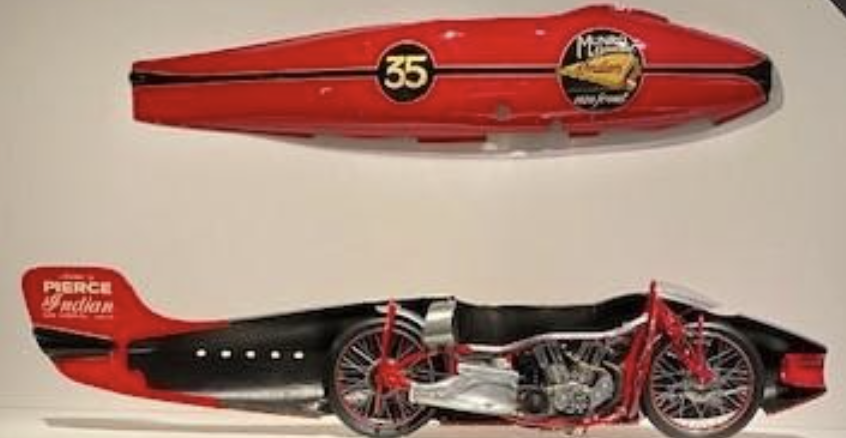
Yes, you can do it and have fun. I never thought in my wildest dreams that I would get excited about motorcycles. Sailing in a sleek yacht across the Mediterranean with bubbles in hand, yes, please. Being a passenger in my friend Anooshka’s red Maserati, yahooing through the neighbourhood, yes, I didn’t think I would, but I did enjoy it. Even riding a bicycle along the Riverwalk, pleasant, with the wind nearly blowing my hat off, I like. But motorcycles? Sure, my son has a Harley Davidson that he raves about, but he lives in Darwin. Yet, as I found out, you are never too old to learn something new or get excited about an experience that is initially quite unfamiliar to you.
As a converted enthusiast, I can share my knowledge that the visit to this fabulous and exclusive Motorcycle exhibition at the Gallery of Modern Art is fun, enlightening and a lesson in history. Daring innovation and a passionate desire to use wheels instead of legs created the modes of transport that you can marvel at in this display.
For example, did you know that the Perreaux Steam Velocipede, generally considered to be one of the first motorcycles ever built, was made in 1871 by Frenchman Louis-Guillaume Perreaux. It was powered by a steam engine, fuelled by alcohol, had wood and iron-banded wheels, delicate handlebars and a high seat that perched precariously above the brass-plated boiling steam engine. It could travel at a revolutionary 14 km/h. If you are interested in the technical data, the Engine is 30 cc steam @ 3.5 kg/cm² (50 psi), with Power: 1-2 hp. This Perreaux is the only known example and you can see it at GOMA.
Would you like to be driven around in a luxuriously upholstered red leather sidecar without being subjected to engine fumes at a fast speed? Then the Minerva with Mills and Fulford Forecar is your mode of transport. Built in 1903 Belgium by Société Anonyme Minerva, the Engine is 239 cc side-valve single, Power: 2 hp. This model was in use for just a few years, which could have been due to the perilous position of the passenger and also the hindered view of the driver.
Did you know that David Spencer of Torwood, a suburb now incorporated into Brisbane’s Auchenflower, built the Spencer in 1906. The Engine is 475 cc side-valve single, Power: 2 hp.
This Spencer motorcycle is one of only two surviving models. Spencer made his own wooden patterns for the iron castings of the engine and other parts. Thus this motorcycle was made almost entirely in Australia. Spencer had a good reputation, indeed the Queensland Police Force ordered 50 motorcycles. Sadly, as is so often the case with Australian inventions, Spencer was not in a financial position to fulfil an order of such great numbers. His production ceased in 1910.
Have you seen the movie The World’s Fastest Indian? It was made in 2005 starring Anthony Hopkins as New Zealand speed bike racer Burt Munro. With his highly modified 1920 Indian Scout, Munro set numerous land speed records for motorcycles at Bonneville Salt Flats in Utah in the late 1950s and early 1960s. Well, if you saw the movie, you will want to see the Indian Scout. And you can, the Engine is 953 cc, OhV 42° V-twin, Power: 100 hp.
In 1967 Munro made his final world-record beating Bonneville speed run in this displayed machine. He was 68 years old and set the speed record of 296 km/h for a motorcycle under 1000 cc.
The exhibition models take us through the years from their inception to present times on different continents of origin. I was amazed that the first Vespa from 1946 has hardly changed in design or shape. This 1960 model has an Engine: 146 cc two-stroke single cylinder, Power: 8 hp. Inspired by desolate post-war Northern Italy Enrico Piaggio saw a need for affordable transportation.
When you look at the latest models in town, they are not too different. Which proves to show that what has quality lasts and does not age.
This one is for you Markus if you are reading SheSociety in Darwin. A Harley Davidson VRSCA V-Rod 2003, Engine: 1130 cc 60° V-twin, Power: 115 hp. How would you like to drive that through the outback?
After seeing so many amazing and exciting models I’d like to conclude with a current model. CAKE Kalk OR 2019, made in Sweden. Engine: Electric motor with 2.6 kWh battery, Power: 11 kW (14.8 hp). The Kalk is a zero-emission electric motorcycle.
It is an off-road machine with the power and capability of a conventional 250 cc motorcycle. Its design sets it apart from any motorcycle maker. Who knows, we might see a Kalk zero-emission being ridden in Brisbane in the not-too-distant future.
Because of the rarity of the displayed models and their interesting history I might just have to visit again. There is still time as the exhibition finishes on 26 April 2021.
Reader, writer and snippeter.
Loves listening to classical music and jazz, visiting art galleries with expressionistic paintings, going the live theatre, seeing movies and absolutely adores, apart from her two gorgeous granddaughters, travelling to Europe.
Readily surrenders domestic chores to meet with friends for any of the three c’s – chat, coffee and champers.

Leave a Reply